You want the perfect pantry! Our 5-step ultimate guide to organizing the perfect pantry can save you time and money in the kitchen.
Before I learned about perfect pantry organization, I learned about the horrible things that can happen when food is forgotten waaaay in the back of an unorganized pantry. Yes, it’s slightly horrifying. Don’t let this happened to you.
I first learned about the existence of a thing called weevils in the summer of 1988. I had just come home hungry from soccer practice, and after chugging a massive glass of water, I popped open the pantry in search of a snack.

Flour? Not edible.
Oats? Not sweet.
Dried Melba toast dusted with cinnamon sugar? That’ll do.
Despite being dry, kinda stale, and sickenly sweet from the granulated sugar, the Melba was totally hitting the spot. So I scarfed down a second piece. Then a third. And then I felt something move… in my mouth.
I’m not sure which I noticed first: The swarm of tiny bugs waving angrily at me from my Melba bite mark, or the queasy vomitus feeling of needing to hurl the contents of my stomach.
I swallowed my hurl. It was the 80s after all, and teenagers back then only gagged on spoons.
Anyhoo, my mother wasn’t impressed with the discovery. A registered nurse whose floors were often clean enough to dine off of, she was horrified by the level of insectal movement in her pantry.
She removed everything from all shelves, seeking the source of the mysterious infestation.
It was a bag of flour. That powdery white stuff no one used and everyone ignored was ground zero for the biggest household upheaval since both my sister and I had hit puberty.
The infestation was both awful and awesome. We chucked the food most teenagers hate, I got to witness both parents freak out, we bought a bunch of cool plastic containers, and we hermetically sealed anything wholesome enough to grow wings.
I learned a lot about organizing the perfect pantry during The Great Weevil Infestation of ’88. I also never ate Melba toast caked in sugar again.
This is the ultimate guide to organizing the perfect pantry.
1. Raid your not perfect pantry.
When I told Carl I wanted to do a pantry raid he got very excited, and walked around the house with a big grin on his face. The smile left his lips an hour later when he saw me stack dried beans, quinoa, and assorted cans on the kitchen floor. A ‘pantry raid’ ain’t the same thing as ‘panty raid’, hon. Sorry.

The best way to start organizing your perfect pantry is to empty your cupboard and group your foods by type on the floor. It doesn’t matter if your pantry is a walk-in room or a modest kitchen cabinet — empty the lot to make the most of this exercise.
Canned goods in one pile, dried beans in another, spices in a stack, and baking goods far away from the kids.
Seeing your wares together on the floor can help you see what’s in stock and what’s been hanging out in your kitchen for years.
2. Archive the pantry artifacts.
Grab my handy Food Waste Diary and make note of all the expired items you’ve been storing in dire need of a compost bin or trash can. Check over your canned goods. If they’re expired, rusting, oozing, or bulging, toss them out!

Save Money — Keep a Food Waste Diary
Download our free Food Waste Diary to see how much food is being wasted in your household. Results may shock you.
Scrutinize the non-expired stuff you’ll never eat and donate it to your local food bank. You’ll clear space for foods you enjoy, and perhaps make better use of your pantry when preparing meals in the future.
Also, be sure to open and inspect all bags, boxes, and canisters containing grain products. Many bugs, but mostly weevils, love breakfast cereals, crackers, cookies, cake or muffin mixes, pastas, and pancake powder. They also love big bags of warm flour.
Kill Bugs Cold: Weevils do not like the cold. If you’re unsure about the insect activity in your flour, an alternative to chucking (what might be perfectly good food) is to freeze questionable items for at least four days. The cold kills eggs, larvae, and weevils.
To prevent future infestation, find some space in your freezer and freeze the f-ckers cold. After the Great Weevil Infestation of ’88, our family stored all bags of flour in the deep freeze full time. It was a smart way to prevent food waste, and the move saved my parents some needed sanity.
For those with small freezers who cannot afford the space, be a smart shopper and buy smaller portions of these products and use them regularly.
Your kitchen floor or countertop may look like a disaster. Don’t worry — things often get worse before they get better. Hugs.
3. Clean Pantry: Get scrubbing.
I lied. Things will get better in a minute. First, grab your vacuum and get down with the biggest de-crumbing you’ve endured since discovering that chowing on potato chips often sends flying potato pieces straight into your cleavage (if you’re a woman).
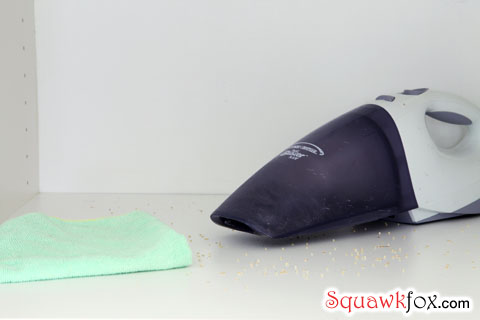
Be sure to vacuum all cracks, crevices, cleavages, and spaces where grains of food could be hiding. If your pantry shelves are lined, remove the contact paper — you can reline later.
Grab a clean cloth (I use microfiber) and wipe down your pantry using a mixture of warm water and a few drops of dish detergent. Wipe it dry.
Reline your shelves with your preferred liner (IKEA sells some), or stock up on reusable non-adhesive shelf liner — just cut to size.
4. Do a pantry inventory.
With a clean pantry nearly ready to rumble, it’s time to take inventory.
Food Inventory: Why keep an inventory?
A pantry inventory details what you have stocked, shows what needs to be added to your grocery shopping list, and may inspire you to make meals with the ingredients you have on hand.

Free Download: Printable Pantry Inventory (pdf)
Keeping a pantry inventory can help with meal planning since you’ll know what’s at home and what needs to be purchased. An up-to-date inventory can also make shopping less wasteful, saving you big money on your grocery budget. Who knows, maybe you can skip a supermarket trip!

The Organized Meal Plan
Save money. Save time. Save your sanity. Download our free 7-day printable meal planner to get better organized during your busy week.
What to record in your pantry inventory:
- Item: What’s in your pantry? List canned goods, rice, dried beans, spices, cereals, snacks, quinoa, oatmeal, etc.
- Quantity: How much is in stock? Do you have canned tomatoes to make stew this week? Quantity is an ongoing itemization of what you have in stock and what is about to run out. Make sure the kids update this column too!
- Item Cost: You keep your grocery receipts, right? Go ahead and list the money spent on your food. It’s easiest to update when you’ve just done the groceries and restocked your perfect pantry. This column can be a real eye-opener when you add up the total cost.
If you’re loving this level of organization, go ahead and check out this very popular post on refrigerator organization.

5 Steps to a Freshly Frugal Fridge
What’s inside your refrigerator? Prevent food waste and save money by getting your fridge organized and storing items in the smartest spots.
Lots of helpful tips, great graphics, and easy steps to keep your food fresher, for longer. Check out The Organized Fridge for the details.
When you’re done listing all your pantry wares, stick your pantry inventory on the inside of a door. Update as needed.
5. Organize Pantry: Get in the zone. Reload.
Before restacking everything back on the same old shelf, consider the spots where everyday foods could be placed to make access easy. For example: Shoving your favorite breakfast cereal behind a wall of canned goods is a bonehead move, unless you’re hiding those tasty oats from a kiddlet or husband.
Pick a pantry zone.
A few organizational ideas to get your pantry perfect:
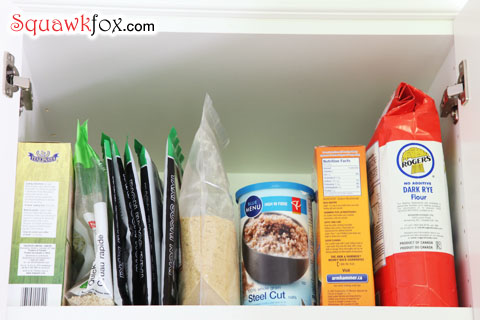
Zone 1: Non-essentials. Store foods eaten less often, napkins, trays, etc. in less accessible spaces.
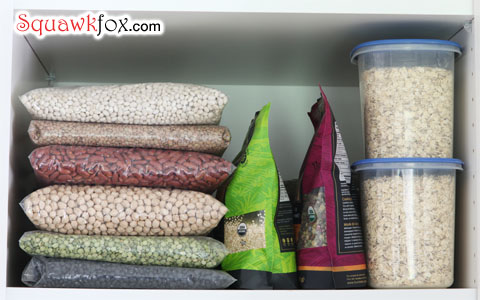
Zone 2: Dry ingredients. Store dry ingredients in airtight containers to keep freshness in and the bugs out. Clear containers alert you to when stock is running low.
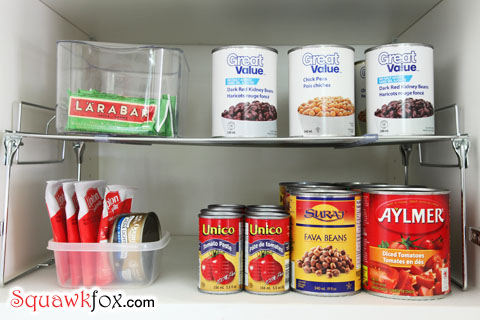
Zone 3: Get canned. Arrange canned goods in rows on a lower shelf. For safety, don’t stack high. Use wire shelves to maximize space.
Zone 4: Easy Meals. Store breakfast, lunch, or dinner foods on an eye-level shelf so rushed and hungry family members can find food fast.
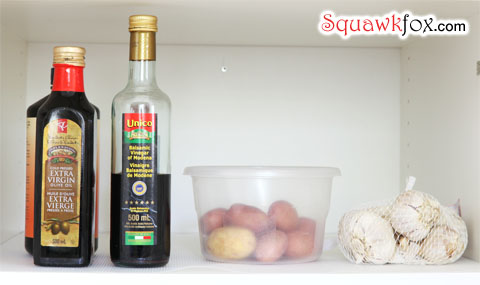
Zone 5: Spillables. Place oils and vinegars on a spill-proof mat, and store non-refrigerated vegetables (potatoes, onions, etc.) in a cool dry place.

Zone 6: Special cases. Is there a family member who needs a special shelf for a unique diet? Keep a gluten-free pantry shelf for those with wheat allergies. Infants and toddlers may need space for bottles and kid-sized utensils.
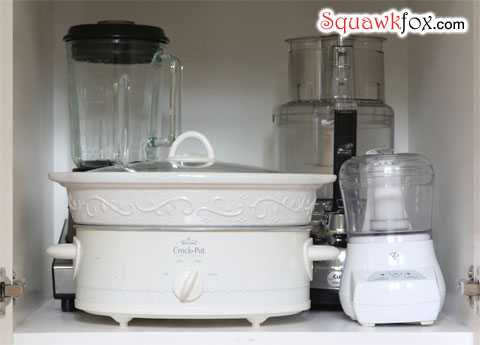
Zone 7: Appliances. Keep your crock pot handy, your blender in the mix, and other tools on a shelf nearby.
Zone 8: Step up! Stash a step stool nearby when highest shelves are out of reach.
A few perfect pantry organization tactics:
- Get grouped: Group similar stuff together by food type or meal. Dry goods on one shelf, canned on a second, spices stored in labeled jars, oils and vinegars on a spill-proof mat, non-refrigerated vegetables (potatoes, onions, etc.) in a cool space.
- Square containers: Skip the round ones — use square airtight storage containers to to keep dry ingredients fresh and maximize your space. Square containers can be easily stacked and waste less space than round models. Airtight containers are a great tool for preventing insects from infesting your wheat products.
- Expandable shelves: Expandable wire shelves double your space and help keep things stacked safely. Place a double wire shelf in the back of your cabinet and stack canned goods on it.
- Don’t get canned: Never stack canned goods on the highest shelves or on top of each other — they could topple and make a mess, damage something, or even injure you. Use a wire shelf as support to safely stack double-height.
- Shoe racks: Got an old IKEA hanging shoe rack hanging around your home? Hang it on the inside of the pantry door and store small items (potatoes, onions, spices) out of the way.
- Bin there: Bins and baskets do a great job of separating and organizing items on pantry shelves.
- Pantry rotation: Whenever you restock your shelves, rotate older wares forward from the back of your pantry. You’ll keep your food from spoiling!
May your organized pantry be perfect.
Love,
Kerry
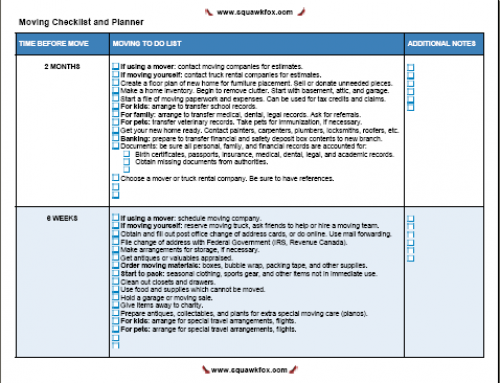
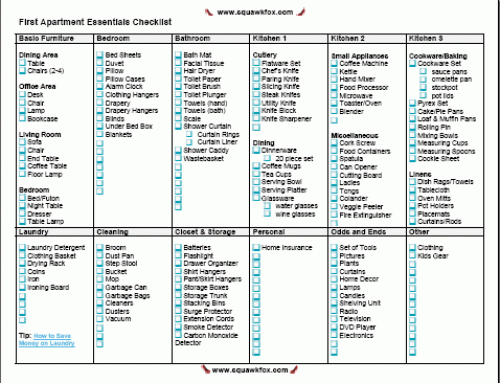
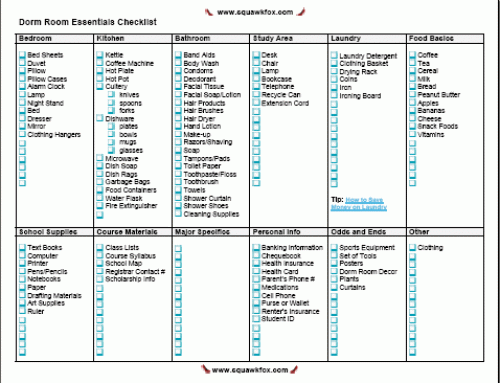
A year ago I found a couple of pantry moths in a container of brown rice. I buy rice in jumbo-sized bags, so still had quite a lot left and didn’t want to toss it all. I packed up all the rice in plastic containers and rotated them in and out of the freezer. As I cooked the rice, I would wash it first and scoop out anything that resembled a moth. I found only a couple more. Since then, I put all grains into the freezer for 24 hours before they are moved into the pantry. I have yet to see a single pantry moth or weevil since. Everything is stored in plastic bins or bags. Nothing stays in a paper bag.
If you have a really bad problem, as sometimes it just seems to be the year, pantry moth traps that use pheromones to attract the moths, work extremely well, if used in addition to freezing all grains before storing (so you’re not just bringing in new bugs each time you shop).
Love this Kerry. I got invaded last year and dubbed it weevilgeddon. Was awful. I now have everything in giant mason jars. And I pop all flour and pet food in the freezer or fridge to help. Works like a charm. I think it’s good you clarified the difference between a panty and pantry raid. That could have spelled disaster.
1. Throw some bay leaves in the tupperwares and some on each shelf. Keeps the bugs far far away.
2. I would suggest unloading onto the kitchen table or countertop… I’ve got dogs and a cat running around on my kitchen floor, and no matter how clean it is, sitting foods where the critters run around is a no-no in my book 🙂
[…] How to Organize the Perfect Pantry | Squawkfox […]
Hi there, great article! Here is a tip: when bringing home any ‘dry goods’ from the store, such as flour or oatmeal, all you need to do is freeze the whole bag for 24 hours and then put it on the shelf. Any lifeforms that hitched a ride (insect eggs, for example) are killed and there is no chance they will develop further. Of course, as you wrote, storing things in airtight plastic containers is a great idea, the freezing stage just adds the assurance that nothing comes alive into your cupboards in the first place. Personally, I think grocery stores should offer the option of customers buying pre-frozen flour and oats, because sometimes my freezer is too full for a big bag!
Ooops, sorry folks, I just read through the comments and realized I’m not the first one to post the freezing idea! Glad to see there are many savvy people out there! : )
I am 69 and you are teaching me things I should have known a long time ago. Organization is WAY down on my list of accomplishments. You are an inspiration, a very funny, positive and inspiring guide. Thank you for your time and all your valuable information.
[…] How to Organize the Perfect Pantry […]
Just cleared out my pantry using your method. Awesome blog, thanks for the inspiration!
Just so you know, potatoes and onions should never be stored together – they make each other “over-ripen” and go soft and bad quickly. However, storing your potato CHIPS and onion RINGS together – now that is *organized* for when you get your salty-crunchy craving on! 😉
Excellent article! Most important was “going public” with the whole bugs-in-the-cupboards issue that has so many people believing it’s “just them.” No, it’s not just people on “Hoarders” who have this problem, LOL. My mom was grounded with a bad fracture during my high school years and Dad was always working, so I was the one who discovered the bugs and larvae on the top shelf where the spaghetti was kept. Have never kept flour or sugar loose in the bag since that day. Brown rice, however — Lili’s comment made me go “Hmmm!” Haven’t found any intruders, but I do typically just keep it in the plastic bag it comes in, folded over and clipped. Maybe the freezer method would be wise, considering the triple-digit summer we’re having. Thanks again.
Best first sentence ever. 🙂 Thank you for such a helpful article! I had run out of ideas for maintaining some kind of order in my family’s pantry until reading your post. I will commit to using the great system that you’ve outlined.
[…] read this article and couldn’t wait to clean out my pantry. As neurotic and crazy as it sounds I wrote down […]
I live in the deep south in the middle of what used to be farmland. Our major problem is field mice. They come in when it too dry, wet, hot, cold, etc. What I’m trying to say, they get in all the time. It drives me insane. With the assistance of my trusty exterminator, I keep everything in my pantry sealed tight as a drum and high up on shelves. They will get into anything they can knaw through. This is a fantastic article, thank you for all the pointers. I will put this into action tomorrow!!
Dawn! I won’t sleep tonight thinking of you with mice sneaking into your house! You need a cat (or two!) We had a mouse once, and I learned some amazing (and awful!) things about mice. If there is a hole big enough for a pencil, they can fit through. They can jump quite high, 18″ or more. Also, one female can birth up to 80 baby mice per year! Best of luck with your mouse problem, I hope you and your exterminator are successful in removing them. : )
Hi Dawn, We had a few of the mousey types invade our home last year. Carl managed to capture the little beasts by using a cheapie mouse trap baited with peanut butter. Not sure if this will work on Southern mice (they may be smarter then our Deer Mice) but it’s worth a try.
Just returned from vacation after two weeks to find my pantry in a real mess not bugs but husband. I now have to clean it out great tips to make the job easier and hopefully it won’t be so bad in future. Great website just found it after reading your book.
I once used mason jars to store my dry goods (the older kind with the glass tops and metal rims.) Having everything in glass jars was very pretty until I saw little black bugs walking in my rice jar. Turns out weevils can get into mason jars.
Nadine, I don’t know that the weevils got in the jar…my bet is that they were eggs in the rice to start with. I had weevil moths in my dehydrated bananas this year. They were in the bananas before they were dehydrated. Then they hatched in the baggies. No holes in the baggies. I would have thought the heat would have done them in, but it didn’t.
Great artcle! Thanks for the great tips for keeping lists of what I have on the shelves. It will help a lot when shopping.
I also wanted to remind those of us who have pets and buy dry pet food. Treat the dry food as you would rice, flour or other grains that may contain bugs. Be careful where you buy your pet’s food if it’s not at a nice clean grocery make sure there aren’t any bugs flying around the store or that the bags have no holes or traces of bug or mice activiy. Happy shopping!
[…] website via Pinterest by searching “pantry organization” and so far, so good. Check out Squawkfox! So far I am on page 4 of all the stuff in my pantry and I still have a bit further to go. […]
Oh, gross! Can’t imagine finding the weevils by finding them IN MY MOUTH. Ugh.
Also wanted to add that if your special-diet family member is very sensitive, it might be good to store his food on a higher shelf than the “regular” food, so crumbs and such don’t fall in. Probably not as big a deal with stored, packaged food as food on a buffet or something, but still maybe not a bad idea for a super-sensitive eater.
Instead of shelf liners I use press and seal wrap on my shelves. Super easy cleanup and you can just peel it off and redo it whenever needed.
Lot of wasted space, could use the door to add wire racks for spices and such
We had a pantry moth infestation that lasted YEARS. Those critters are so hard to get rid of that some exterminators I called wouldn’t even come out. Even with a good exterminator and regular treatments, and constant vigilance, we’d get less of a population followed by a new population explosion. Airtight containers were no match for them. Sealed boxes of cake and cookie mixes and crackers were even breeding grounds. One day I realized that I had two cupboards where we had never seen moths or larvae. One was the appliance garage where our toaster sat and those moths should have been attracted to the toast crumbs. But do you know what else was in both those cupboards? My TEA BAGS! We threw everything out one more time, bought a few boxes of inexpensive tea and placed a box in each cupboard. We waited a couple of days before placing new food in the cupboards but left the boxes of tea bags in each one. Problem solved. There were a few strays that flew around for a couple of days but they didn’t find a place to breed. Our exterminator even told some of his other customers that it might be worth a try and it worked for every single one of them. I still keep a paper cup of teabags in every cupboard and have never had a problem with any kind of insect since then. In fact, they sometimes hitch a ride home with my husband who works in hardware store where the bird seed gets infested, but they don’t live long once they get in. I’m assuming it’s the tannic acid/tannins in the tea warding them off.
I’m not nearly 72 and drop things frequently – like large shampoo bottles on my toes. Found some colorful ketchup and mustard bottles with the squirty end – put the shampoo, conditioner, bath gel and anything else I had smacked my toes with. They work great, easy to use, hold and squirt.
Since this worked well have put stuff in smaller lighter containers that are easy to hold. The dollar store is a great place to look for them.
I have kept a panty list and a deep freeze list in books for years. I just take the
books out when I make my grocery lists and everything is so easy. I mark
things off when I take one each time and saves so much looking…
Kerry, your humour always makes my day. 🙂 I’m now also inspired to organize my kitchen. Squawkfox devotee 4ever.
tea w. Thank you so much. YOU have made my day. Love love love, Kerry
Oh man! We had a similar story in the 80s. We didn’t have a pantry, but a million cabinets with good stored in them. So it was truly a hubt for weevels. Blech.